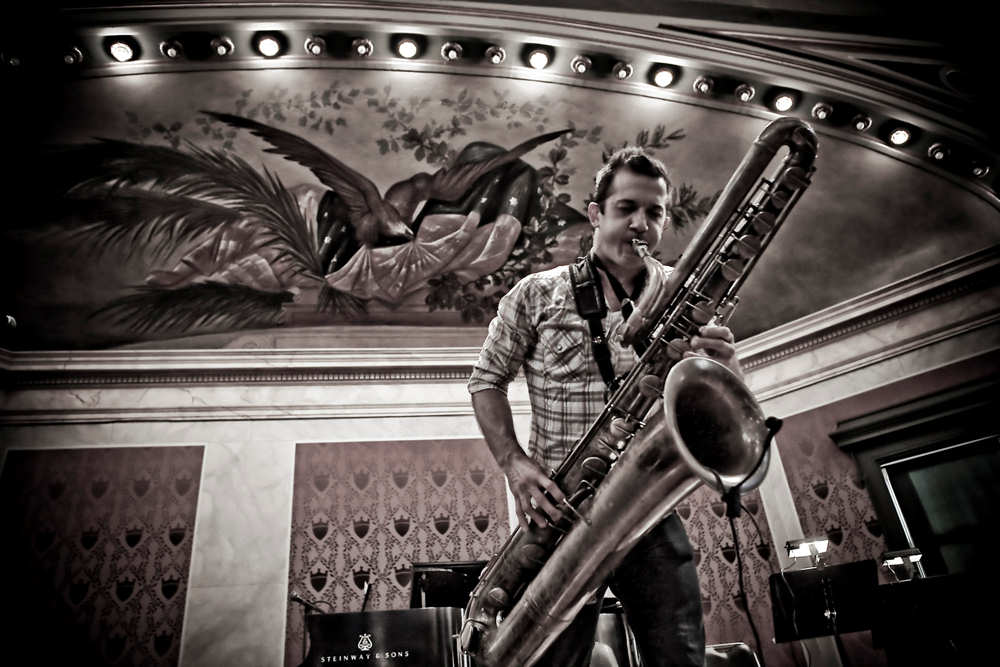Saxophones are monophonic instruments, right? Or so we’ve been led to believe.
As long as we’ve been playing, our instructors have taught us that saxophones play 1 note at a time. Sure, they are capable of performing multiphonics, but for the most part, it is not a technique that 90%+ (I’m totally guessing here, but that’s based on the performers I’ve worked with) of players use. And those who do use the technique, use it as an effect, or for certain notes only.
Enter Colin Stetson: a man who yesterday literally changed the way I think about saxophones, and what they are capable of.
Source: colinstetson.com
Sure I play bass sax. Sure I use a lot of effects—including multiphonics—in my playing. But after listening to Stetson play, I feel like I’m back in preschool again when it comes to this stuff.
Vancouver is currently hosting its annual, International Jazz Festival. Yesterday I had the opportunity to hear a 1 hour solo performance by Colin Stetson at the Round House Performance Centre. It blew my f#!*ing mind. Seriously it did.
In February of this year Stetson released a new album titled, New History Warfare Vol. 2: Judges. At yesterday’s jazz festival performance, he performed a number of tracks from this album on bass and alto saxophones.
Before you listen to this, you should know that this recording—just like the performance I saw yesterday—was done with no overdubs or loops. Yes, he is playing everything you hear simultaneously through his bass saxophone. (The only exception is Laurie Anderson’s spoken part at the end of the recording, which was obviously not present yesterday when he performed this piece live.)
According to his label, Constellation Records, Stetson:
combine[s] a mastery of circular breathing technique with percussive valve-work and reed vocalisations, making a polyphonic solo music that combines [diverse] influences…Stetson is able to weave an uninterrupted flow of arpeggiated swirls and chordal progressions while simultaneously singing yearning melodic lines through the reed of his horn – a technically powerful combination, exponentially intensified by Colin’s innate sense of pace, phrasing and trajectory.
Judges by Constellation Records
Reviews of Judges, explains in part how Stetson creates his unique sounds:
Twenty microphones, planted like roses around a room – capturing the ripple of notes, the wails of resonance, the violent clack of fingers on keys and the shriek of Stetson’s own voice, sounding through the horn;
Source: Said The Gramophone
While someone else writes:
Maybe more than anyone, he is taking the instrument to NEW places, with NEW technique. Moreover, he takes an acoustic instrument and prepares it with multiple microphones and contact mics, making it a draining, rewarding, physical and visceral expierience. It is fucking impossible, what you are hearing on this record. There are so many, CRUSHINGLY beautiful sounds coming out of one person, at ONCE, that it makes your skin tremble, your mind go blank, and your eyes close.
Source: Justin Vernon (Bon Iver)
Colin Stetson is originally from Ann Arbor, MI, and did his a degree in music at the University of Michigan. After a decade of work on both coasts in the US (6 years in San Fransisco and 4 years in Brooklyn, New York) he relocated to Canada, and now lives in Montreal, Quebec. He performs regularly on assorted saxophones, clarinets, flute, cornet, and French horn.¹
Besides having a busy solo career, Stetson has worked with a wide variety of artists including: Tom Waits, Arcade Fire, TV on the Radio, Feist, Laurie Anderson, Lou Reed, David Byrne, Jolie Holland, Sinead O’Connor, LCD Soundsystem, The National, Angelique Kidjo, and Anthony Braxton.²
Source: colinstetson.com
After the show I saw yesterday, Stetson was swamped by people all wanting to buy his CD. He also had another performance only 2 hours later, so I didn’t even try and talk to him. There was 1 question I really would have liked to have asked him though: What did he have done with his upper and lower stack keys to allow them to be so percussive?
I’m guessing his tech, or maybe he does the work on his sax himself, sets the keys up a special way to allow them to sound the way they do. Given how hard he strikes them during his performances, how does he deal with the wear and tear on his 1920 something Conn bass?
Regardless if you play bass or not, I would highly recommend you check out Colin Stetson should you ever get the chance. I’m not overstating here: this guy will forever change your view of what the saxophone is capable of. You might not want to play like this, or might not even like it, but it will definitely alter your perception of that instrument that hangs around your neck.
If you’d like to see if Colin Stetson is playing near you, check out his performance schedule on his website.
To hear more samples from, or to buy New History Warfare Vol.2: Judges, check out this page on Constellation Records.
_______________________________________





Crazy and amazing !! Never heard anything so hauntingly beautiful !! 😡
He could have the same effect on the sax that Albert Mangelsdorff had on the trombone. Sounds like there may be some Evan Parker influence as well. Potent stuff!
Hi there Russ. Did you catch any of the jazz fest in Vancover?
Albert Mangelsdorff? Evan Parker? :scratch: I guess I’ve been living under a rock! Now you’re going to make me use Google again, aren’t you my friend. 😆
Albert Mangelsdorff made multiphonics an integral part of his style, essentially turning the trombone into a chordal instrument. He combined considerable technique with immense musicality. His solo trombone recordings are a delight to hear. I can’t say enough good things about him.
Evan Parker was one of the earliest saxophonists to use circular breathing extensively (primarily on soprano), playing repeating figures with enough subtle variation to keep it interesting. His playing is definitely “outside”, mostly non-tonal, but quite compelling to these ears.
No to the Jazz Fest. Just didn’t work out with my schedule. 😥